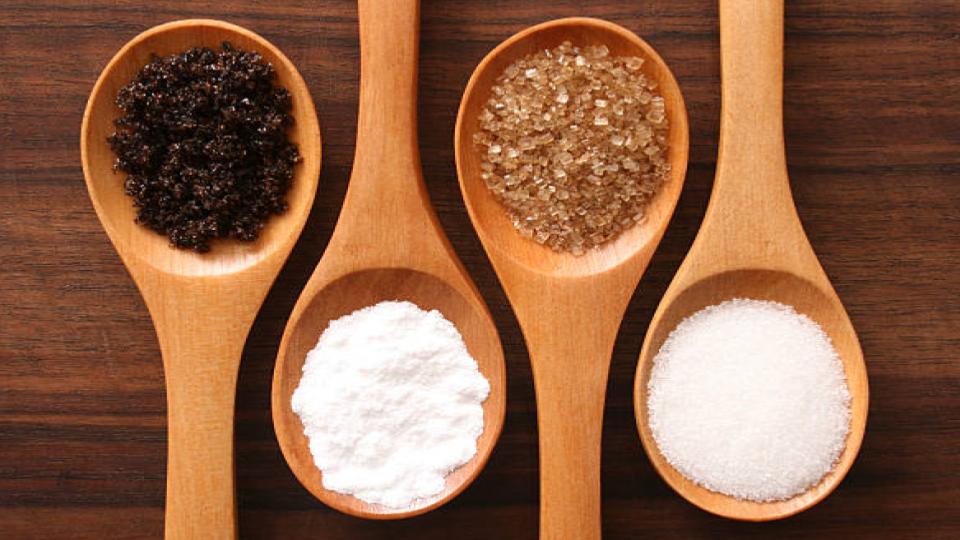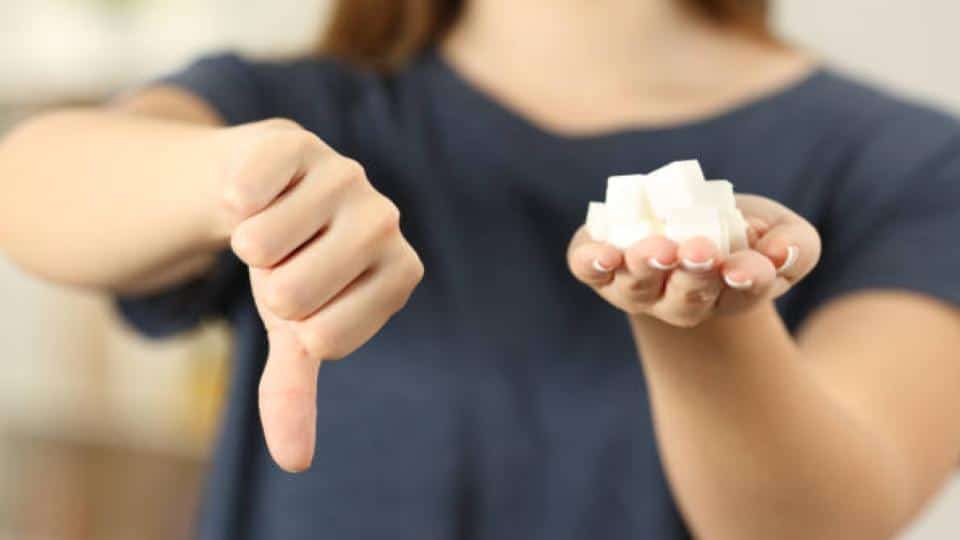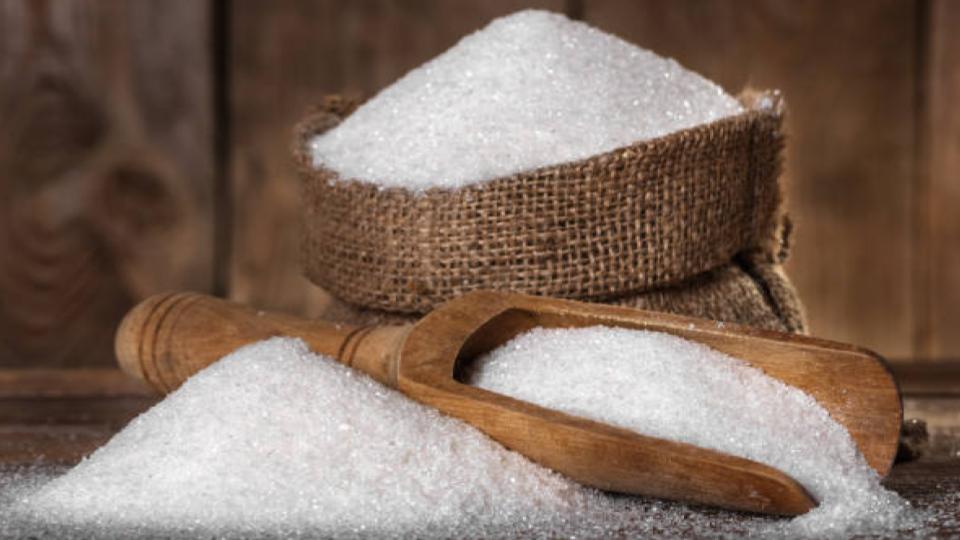Ways to Store Sugar Long Term

Table
of
Contents
When
most
people
decide
to
store
sugar,
they
first
think
about
how
to
remove
oxygen
from
it.
They
assume
that
oxygen
moistens
it.
But
that’s
not
necessary
or
wise
when
dealing
with
sugar
because
removing
oxygen
hardens
it.
If
you
do
that,
you’ll
have
a
massive
rock
when
you
open
the
container
months
later.
It
doesn’t
mean
the
sugar
won’t
be
safe
for
consumption.
No,
you
can
use
your
rock-like
sugar.
But,
you’ll
need
a
mallet,
a
chisel,
or
a
drill.
So,
let’s
look
at
how
to
store
sugar
long-term
to
maintain
its
texture,
flavor,
and
color.
First,
here’s:
How
to
Tell
Sugar
Is
Bad

It’s
almost
correct
to
say
that
sugar
lasts
forever
as
it
can
stay
for
years
as
long
as
the
storage
conditions
are
favorable.
That’s
the
case
for
all
sugar
types,
whether
you’re
storing
brown,
white,
or
powdered
sugar.
Bugs
and
water
are
two
contaminants
that
may
change
the
quality
of
sugar.
You
let
them
into
your
sugar
by
using
packaging
that
leaks
or
using
packaging
that’s
dirty
or
humid.
How
can
you
tell
when
your
sugar
is
bad?
Check
the
Smell
Sugar
has
no
smell.
But,
if
you’ve
stored
it
next
to
foodstuffs
with
different
odors
and
scents,
it’ll
acquire
them.
It
doesn’t
mean
you
can’t
use
that
sugar
anymore.
However,
when
you
do,
your
drink
or
food
will
have
all
the
scents
in
the
sugar.

That’s
why
you
may
consider
discarding
that
sugar
altogether.
For
example,
imagine
having
a
cup
of
coffee
with
the
taste
of
apple
pie.
Odors
are
common
when
you
refrigerate
or
freeze
sugar.
Powdered
sugar
may
also
taste
different
when
it’s
stale.
Look
for
Changes
in
Texture
When
you
have
to
break
lumps
to
scoop
some
sugar,
you
may
want
to
reconsider
how
you
store
it.
Sugar
lumps
crop
up
as
the
sugar
hardens,
meaning
something
is
going
on
in
the
storage
area.
Don’t
discard
it
as
it’s
still
of
good
quality.
First,
break
the
lumps
to
regain
the
natural
form
of
the
sugar,
then
change
the
storage
area.
Break
up
the
large
sugar
lumps
with
a
fork,
then
refine
the
particles
in
a
food
processor.
We’ll
discuss
other
methods
to
remove
sugar
lumps
later.
Check
for
Mold
Mold
can
grow
in
powdered
sugar
when
water
seeps
inside.
It’s
the
same
case
with
sugar
stored
in
buckets
in
the
basement,
in
moldy
conditions.
Since
sugar
is
hygroscopic,
it
draws
in
water
molecules
from
the
surrounding.
That
being
the
case,
when
you
leave
it
in
moldy
conditions,
water
seeps
from
the
concentrated
conditions
outside
the
bag
into
the
sugar
particles
through
osmosis.
Look
for
Bugs

If
you
leave
your
bag
of
sugar
open,
you’ll
find
all
manner
of
critters
inside.
Insects
can
also
live
on
the
rim
of
your
container
or
the
lid.
Thus,
inspect
the
container
or
food-grade
bucket
for
leaks.
If
there
are
cracks,
chances
are
there
are
bugs
inside.
You
may
notice
eggs
inside.
Such
sugar
is
not
fit
for
consumption,
and
you
should
discard
it.
What
Makes
Sugar
Go
Back?
When
you
expose
granulated
sugar
to
moisture,
it
gets
lumps
and
hardens.
It
becomes
difficult
to
store
or
use
in
that
form.
Brown
sugar
also
lasts
a
lifetime,
but
its
texture
can
change
as
it
hardens.
Thus,
we
can
say
brown
sugar
is
good
for
about
two
years
before
it
becomes
lumpy.
Plus,
the
texture
of
powdered
sugar
changes
when
the
storage
container
isn’t
air-tight.
Sugar
also
spoils
when
you
heat
or
freeze
it.
When
you
expose
it
to
heat,
it
darkens.
For
honey,
when
you
heat
it,
the
flavor
changes.
If,
on
the
other
hand,
you
freeze
sugar,
it
crystallizes.
On
top
of
that,
you
expose
it
to
odors,
and
since
sugar
has
a
higher
surface
area.
Most
sugars,
such
as
honey
and
granulated
sugar,
have
an
indefinite
shelf
life
because
of
their
antimicrobial
properties.
But,
it’s
better
to
use
it
in
about
two
years
to
consume
it
in
good
quality,
without
lumps
and
other
unexpected
outcomes.
Storage
Tips
How
you
store
your
sugar
dictates
how
long
it’ll
stay
fresh.
The
solution
is
to
portion
it
instead
of
taking
out
a
whole
bag
of
sugar
that
you
can
consume
in
months
to
a
year.
Here
are
storage
tips
for
your
portions
in
the
pantry.
Storage
Conditions
For
honey
and
other
liquid
sugar
types,
store
them
in
a
cool
place
without
humid
conditions.
Further,
keep
sugar
away
from
hot
or
freezing
temperatures
to
maintain
its
texture,
flavor,
and
color.
Storage
Containers
Polythene
Bags
These
are
simple,
affordable
ziplock
bags.
Sugar
absorbs
odors
fast;
therefore,
don’t
use
plastic
retail
packaging
for
sugar
you’re
not
using
soon.
Instead,
store
it
in
a
polythene
bag
for
it
doesn’t
block
all
oxygen,
meaning
the
contents
won’t
get
hard.
The
only
drawback
of
using
these
bags
is
that
they
damage
easily,
which
may
expose
sugar
to
elements.
Thus,
you’d
have
to
place
these
bags
with
sugar
in
a
food-grade
bucket.
Mylar
bags
These
store
sugar
long-term,
and
you
can
also
place
them
inside
a
food-grade
bucket.
You’re
also
able
to
portion
it
accordingly,
whether
for
monthly
or
weekly
use.
Food-Grade
Plastic
Buckets
It’s
easier
to
store
sugar
in
a
bucket
as
you
can
stack
buckets
together,
so
they
don’t
take
up
much
of
your
storage
space.
Buckets
don’t
damage
easily
like
plastic
bags.
Plus,
you
can
reuse
buckets
for
other
household
tasks
once
you
empty
the
sugar.
Instead
of
pouring
sugar
into
the
bucket,
package
it
in
polythene
or
mylar
bags,
then
place
them
inside
the
bucket.
That’ll
protect
the
contents
if
the
bucket
cracks.
Jars
and
Cans
Canning
jars
are
more
expensive,
but
they
are
better
than
jars
not
meant
for
food.
When
you
fill
a
canning
jar,
leave
about
half
an
inch
at
the
brim
so
you
can
screw
it
tight.
Of
all
the
storage
methods,
canning
jars
are
the
most
appealing,
and
you
can
also
stack
them
in
your
pantry
like
the
food-grade
buckets.
But,
they
store
a
small
amount
of
sugar
compared
to
polythene
bags
and
food-grade
buckets.
You
can
use
these
to
portion
monthly
sugar
packages.
Don’t
use
metallic
containers
to
store
honey,
as
its
acid
can
make
the
container
rust.
How
to
Soften
Hard
Brown
Sugar
What
if
your
sugar
hardens?
Granulated
sugar
loses
its
quality
when
exposed
to
humidity,
but
brown
sugar
hardens
when
air
enters
the
container
and
makes
it
lose
moisture.
If
possible,
store
it
in
the
retail
plastic
bag
as
it
won’t
let
it
dry.
An
alternative
can
be
a
ziplock
bag,
and
as
you
close
it,
remove
as
much
air
as
possible.
Also,
store
brown
sugar
in
small
batches
to
prevent
overexposure
when
you
open
the
bag
to
get
some
sugar
for
immediate
use.
If
you
forget
one
of
the
storage
tips
discussed
earlier
and
your
brown
sugar
hardens,
one
method
to
soften
it
is
to:
Heat
the
Sugar
in
a
Microwave
-
Pour
it
into
a
microwavable
bowl,
cover
it
with
wet
paper
towels
and
add
a
plastic
wrap
on
top. -
Place
the
bowl
in
a
microwave
and
let
it
heat
for
up
to
two
minutes
in
intervals
of
about
20
seconds. -
Shake
the
bowl
during
these
intervals
to
reveal
the
hardened
layer
underneath.
You
can
let
the
bowl
sit
for
about
an
hour
on
the
kitchen
counter,
still
covered
in
the
damp
paper
towel. -
Next,
uncover
the
bowl
and
fluff
it
with
a
fork
while
still
hot
to
loosen
the
sugar
ball.
Use
it
as
soon
as
it
cools
a
bit.
The
downside
of
this
method
is
that
when
you
heat
a
lot
of
it
in
a
small
container,
there’s
a
chance
the
layer
at
the
bottom
will
still
be
hard.
Alternatively:
Use
a
Slice
of
Bread
Yes,
bread
can
restore
the
moisture
content
in
sugar.
Use
a
slice
of
sandwich
bread
for
every
eight
ounces
of
hardened
sugar.
When
you
leave
a
slice
in
the
container,
it
softens
the
sugar
around
it
first.
Therefore,
rotate
the
bread
slice
around
the
container
to
distribute
its
moisture
to
all
lumps.
If
your
sugar
is
in
a
bowl
or
plastic
bag,
you
can
shake
it
for
the
bread
to
reach
all
the
sugar
lumps.
However,
you
risk
having
bread
crumbs
in
your
brown
sugar.
That’ll
not
happen
if
you
let
the
slice
sit
in
the
bowl
without
shaking
it.
Plus,
the
bread
won’t
leave
a
funny
flavor
in
your
sugar.
Lastly:
Terracotta
Soak
a
clean
piece
of
terracotta
in
water
for
about
half
an
hour,
wipe
it
and
stash
it
in
a
container
with
brown
sugar.
Seal
the
container
for
about
an
hour,
and
it’ll
soften
all
the
lumps
evenly.
You’ll
not
have
some
lumpy
sides
like
in
the
case
of
the
bread
method,
and
even
if
you
leave
the
terracotta
in
the
container
overnight,
the
sugar
won’t
be
damp.
You
can
even
store
it
with
this
piece
long-term
to
prevent
moisture
changes
in
the
airtight
container.
How
Can
You
Soften
Regular
Sugar?
The
solution
is
to
restore
moisture
content
and
eliminate
the
lumps.
Therefore:
Use
a
Damp
Paper
Towel
It’s
like
the
steps
we
discussed
earlier
on
restoring
brown
sugar.
Place
a
damp
paper
towel
on
the
sugar
container
and
cover
the
towel
with
cling
film.
Leave
the
container
covered
overnight,
and
the
sugar
will
be
soft
the
following
day.
Place
an
Apple
in
the
Sugar
Bowl
Cut
an
apple
into
four
quarters,
remove
the
core,
and
place
a
part
of
the
apple
in
the
bowl
with
sugar.
Cover
the
bowl
overnight
and
leave
it
in
a
cool
place.
The
moisture
in
the
apple
will
seep
into
the
lumps
of
sugar
and
break
them
down.
It’ll
soften
so
well,
making
it
possible
to
flake
it
off
with
a
fork.
But,
your
sugar
may
have
an
apple
flavor
depending
on
how
long
you
leave
the
slices
in
the
bowl.
On
top
of
that,
the
apple
slices
will
turn
brown
and
mushy,
and
you’ll
have
to
take
them
out
before
they
mess
up
your
sugar.
Bake
Granulated
Sugar
Let’s
say
you
can
try
this
when
you
don’t
want
to
wait
overnight
for
the
sugar
to
soften.
Therefore,
place
baking
paper
on
a
tray,
pour
the
sugar,
and
bake
it
in
an
oven
preheated
to
200
degrees.
Bake
it
for
about
15
minutes,
turn
off
the
oven
and
let
the
sugar
sit
inside
for
about
an
hour.
The
sugar
particles
will
go
back
to
their
original
form.
FAQs
How
long
can
you
store
sugar?
You
can
store
it
indefinitely,
and
it’ll
be
safe
to
use
when
you
need
it.
However,
there’s
still
a
sell-by
date
on
your
bag
of
sugar
because
that’s
when
the
quality
may
begin
to
change.
If
you
leave
your
sugar
bowl
uncovered,
it’ll
harden.
Also,
if
critters
enter
your
sugar
container,
they’ll
contaminate
it.
You
may
also
have
to
throw
away
your
sugar
when
it
turns
moldy.
Restoring
the
flavor
of
sugar
is
impossible,
but
you
can
change
sugar
texture.
It’s
a
process
that
takes
about
two
hours
to
a
night’s
work,
depending
on
the
method
chosen.
How
long
can
you
store
unopened
sugar?
It
can
last
for
years
if
the
packaging
doesn’t
let
parasites
or
odors
and
moisture
into
the
bag.
Hence,
you
can
place
the
unopened
bag
in
a
sealed
food-grade
bucket
and
store
it
in
a
cool
place.
How
do
you
store
sugar,
so
it
doesn’t
get
hard?
When
sugar
loses
moisture,
it
turns
into
a
rock
that
you’ll
have
to
regrind
to
use.
If
you
freeze
or
refrigerate
sugar,
it
condenses
and
hardens.
For
bulk
storage,
use
food-grade
buckets
with
plastic
lids.
It’ll
retain
its
quality
and
keep
insects
like
ants
out
of
your
sugar.
We
also
looked
at
ways
to
soften
sugar
earlier.
Final
Thoughts
Sugar
is
one
of
the
few
commodities
with
a
long
shelf
life.
We’re
talking
years
to
decades
of
the
same
quality.
But,
there’s
something
you
have
to
do.
You
have
to
store
it
in
conditions
that
don’t
change
its
texture,
flavor,
or
color.
If
they
do,
you’ll
have
crystallized
or
hardened
sugar.
That
means
your
choice
of
packaging
and
storage
area
matters.
If
you
have
a
plastic
jar
with
honey
near
a
stove,
it’ll
crystalize.
Also,
if
you
refrigerate
sugar,
it’ll
pick
up
odors
from
pizza,
apple
pies,
and
everything
else
nearby.
Who
wants
that?
